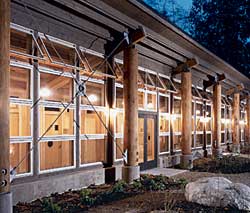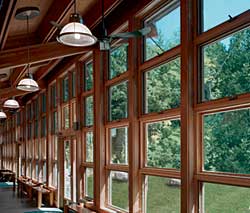Windows and Sustainability: An Environmental Perspective
Rapidly Renewable Materials, Credit 6, addresses reduced use and depletion of finite raw materials and long-cycle renewable materials by replacing them with rapidly renewable materials. Credit 6, worth one point, discusses the use of rapidly renewable building materials and products (made from plants typically harvested within a ten-year cycle or shorter) for two-and-a-half percent of the total value of all building materials and products used on a project.
Since the primary materials used in windows (aluminum, glass, wood, and vinyl) come from sources where the time from origination to harvest exceeds 10 years, windows cannot help on this credit. If the harvest time were increased, many pine wood windows would be applicable. Under Version 2.2, pine does not qualify for LEED certification as a rapidly renewable material. Pine has a 20-year growth and harvest cycle, and is a plentiful, sustainable material.
Certified Wood, Credit 7, encourages environmentally responsible forest management. Credit 7, worth one point, addresses the minimum use of 50 percent of wood-based materials and products, certified in accordance with the Forest Stewardship Council's (FSC) Principles and Criteria, for wood building components including, but not limited to, structural framing, flooring, finishes, furnishings, and non-rented temporary construction applications. Since most wood windows use very little FSC-certified wood, the window contribution to this credit is small. Non-certified wood windows may be used, and the credit can still be earned, through FSC-certified wood in millwork, interior doors, flooring, and other applications.
Indoor Environmental Quality
Windows can contribute to five points in the fifth major category, Indoor Environmental Quality (IEQ). Americans spend an average of 90 percent of their time indoors, where pollutant levels may be up to 100 times higher than outdoor levels, according to the EPA.
|
||||||
Increased Ventilation, Credit 2, discusses providing additional outdoor air ventilation to improve indoor air quality for enhanced occupant comfort, well-being, and productivity. Credit 2, worth one point, has two parts. Mechanically ventilated spaces should increase breathing zone outdoor air ventilation rates to all occupied spaces by at least 30 percent above the minimum rates required by ASHRAE Standard 62.1-2004 as determined by IEQ Prerequisite 1, Minimum Indoor Air Quality (IAQ) Performance. Naturally ventilated spaces should design natural ventilation systems for occupied spaces to meet recommendations in the Carbon Trust "Good Practice Guide 237," 1998. Operable windows to naturally ventilate spaces can contribute to this credit.
IslandWood, a LEED Gold-certified project in Bainbridge Island, Washington, designed by Mithun Architects, is an environmental learning center. This project meets the LEED 1.0 energy credit, which requires no active heating or cooling for eight months of the year. Windows and doors contributed to 12 of the 40 points that helped this project achieve LEED Gold. The windows did not contain FSC-certified wood, but the project earned credit for FSC wood elsewhere. Operable windows enabled natural ventilation.
Low-Emitting Materials, Paints and Coatings, Credit 4.2, aims to reduce the quantity of indoor air contaminants that are odorous, irritating, and harmful to the comfort and well being of installers and occupants. Credit 4.2, worth one point, offers criteria for paints and coatings on building interiors (inside the weatherproofing system and applied on-site). Architectural paints, coatings, and primers applied to interior walls and ceilings should not exceed the volatile organic compounds (VOC) content limits established in Green Seal Standard GS-11, Paints, First Edition, 1993. Clear wood finishes, floor coatings, stains, and shellacs applied to interior elements should not exceed the VOC content limits established in South Coast Air Quality Management District, Rule 1113, 2004. Architects can ensure that VOC limits are stated in the paints and coating specifications.
|












